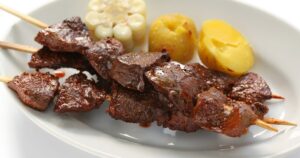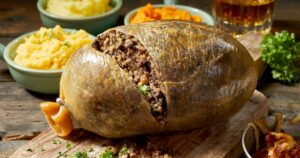Hello there! Today, we’re exploring Chitlins, or as they’re sometimes known in many Southern kitchens, ” chitterlings.”
Now, if you’re scratching your head wondering what on earth Chitlins are, let me enlighten you. Chitlins are the small intestines of a pig. I’m not joking.
Chitlins have a rich, complex flavor profile that can truly elevate a dish. But here’s the catch the taste can vary significantly depending on how they’re prepared.
In this article, we’ll explore their unique flavor and texture. I’ll also give you a broader understanding of this intriguing ingredient. And because I believe in the power of shared experiences, I’ll sprinkle in some of my adventures with Chitlins.
How Do Chitlins Taste?
The taste of Chitlins is often likened to pork but with a stronger, more robust flavor profile. They possess a rich, earthy, and slightly gamey taste. The texture is somewhat rubbery or chewy, similar to calamari, and the smell during cooking is notably pungent.
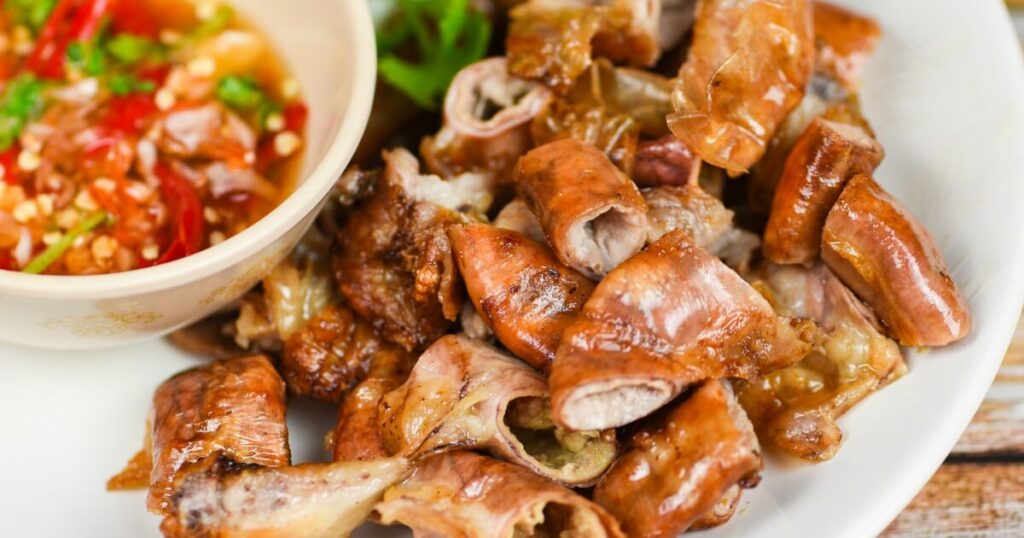
However, the taste and texture varies depending on the preparation method, with some techniques resulting in a softer texture and milder flavor.
When you first bite into a well-cooked chitterling, you’ll notice a certain richness that’s quite characteristic of offal. This is accompanied by an earthy undertone that gives it a depth of flavor not found in more common cuts of meat.
Some folks even detect a hint of sweetness, which adds an interesting contrast to the overall flavor profile.
The texture of Chitlins is another aspect that sets them apart. They’re not quite as tender as most meats, but they’re not tough either. Instead, they have a chewy, slightly rubbery texture that compares to calamari.

It’s a texture that might take some getting used to but one that many people find quite enjoyable once they do.
It’s important to note, however, that the taste of Chitlins can vary depending on how they’re prepared.
For instance, Chitlins that are stewed or braised tends to have a milder flavor and softer texture, while those that are fried are usually more robust in flavor and have a crispier texture.
So, if you’re trying Chitlins for the first time, keep in mind that your experience might differ depending on the preparation method.
What Do Chitlins Compare With?
When it comes to comparing the taste and texture of Chitlins, a few foods come to mind:
- Pork: Given that Chitlins come from pigs, it’s not surprising that they share some flavor characteristics with pork. However, Chitlins have a stronger, more pronounced flavor than most cuts of pork.
- Chicken: Some people find that Chitlins have a taste somewhat similar to chicken, particularly when they’re cooked in certain ways. However, the texture is quite different.
- Calamari: In terms of texture, Chitlins are often compared to calamari. Both have a somewhat rubbery, chewy texture that’s quite distinctive.
- Offal: Chitlins are a type of offal, so they share some flavor and texture characteristics with other offal meats, such as liver or kidneys. They have that same rich, earthy flavor that’s typical of organ meats.
- Game Meat: The slightly gamey flavor of Chitlins is reminiscent of certain game meats, such as venison or wild boar. However, the texture is quite different.
Remember, taste can be subjective, and everyone’s palate differs. So, while these comparisons can give you a general idea, the best way to truly understand the taste of Chitlins is to try them for yourself!
Do Chitlins Taste Good?
Ah, the million-dollar question! Do Chitlins taste good? Well, as with many things in life, the answer to that question is subjective and depends largely on personal preference.
If you enjoy exploring different types of meats and appreciate the rich, robust flavors of offal, then there’s a good chance you’ll find Chitlins quite tasty.
If you’re not a fan of strong flavors or chewy textures, Chitlins might not be to your liking. The flavor is quite pronounced and can be overwhelming, particularly those who are used to milder meats.
The texture, too, can be a bit of a hurdle for some people. It’s quite different from most meats’ tender, juicy texture, and it can take some getting used to.
Then there’s the smell. Chitlins have a strong, distinctive odor during cooking, which some people find off-putting. However, it’s worth noting that the smell doesn’t carry over to the taste.
How To Make Chitlins Taste Good
Cooking Chitlins in a way that brings out their best flavors can be a bit of a culinary adventure. Here are some tips to help you make your Chitlins taste good:
- Cleaning is Crucial: Chitlins need to be thoroughly cleaned before cooking. This not only ensures they’re safe to eat but also helps to reduce the strong smell during cooking and can improve the taste.
- Season Generously: Chitlins have a strong flavor that can stand up to bold seasonings. Don’t be shy with your spices and herbs. Garlic, onion, bay leaves, and chili peppers are all great choices.
- Slow and Low is the Way to Go: Chitlins benefit from slow, gentle cooking. This helps to tenderize them and allows the flavors to develop fully. A slow cooker or a low simmer on the stove is ideal.
- Consider a Pre-Boil: Some cooks swear by a pre-boil to help reduce the smell and soften the Chitlins before the main cooking process. You can add vinegar or lemon juice to the water to help with this.
- Pair with Complementary Foods: Chitlins pair well with hearty, flavorful sides like collard greens, cornbread, or black-eyed peas. These can help balance out the strong flavor of the Chitlins.
How To Eat Chitlins
Chitlins are quite versatile and can be enjoyed in a variety of ways. Here are some popular methods of preparation and dishes that include Chitlins:
Stewed Chitlins
One of the most traditional ways to prepare Chitlins is to stew them. This involves slow-cooking the Chitlins in a flavorful broth until they’re tender and full of flavor. Stewed Chitlins are often served with hearty sides like cornbread or mashed potatoes, which help to balance out the rich, robust flavor of the Chitlins.
Fried Chitterlings
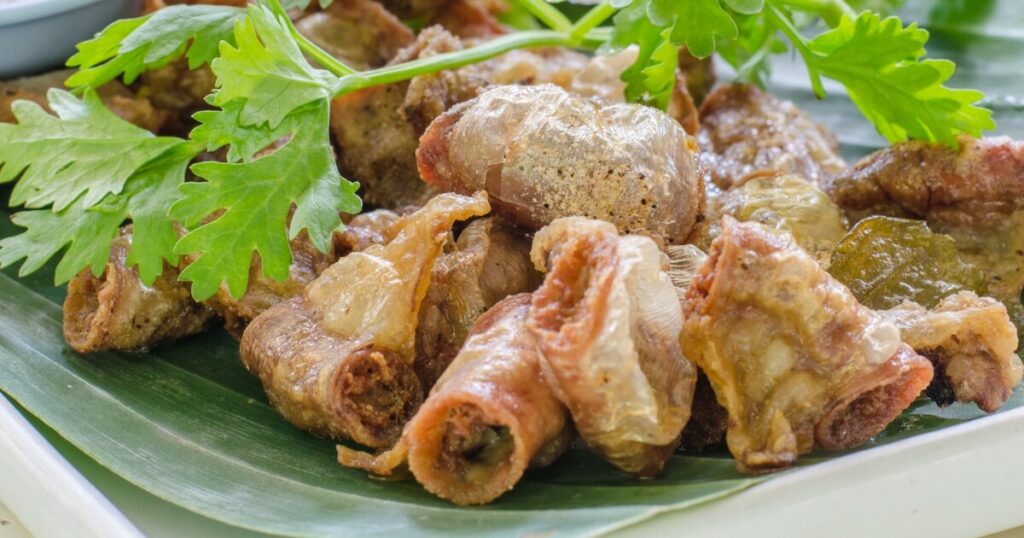
For those who prefer a bit of crunch, fried Chitlins are a delicious option. The Chitlins are first boiled until tender, then breaded and deep-fried until golden and crispy. Fried Chitlins can be enjoyed as a snack on their own or served as part of a larger meal.
Chitlins and Rice
In some cultures, Chitlins are served over rice. The Chitlins are usually stewed with various spices and seasonings, then served over a bed of fluffy, steamed rice. This dish is a great way to enjoy the unique flavor of Chitlins, as the rice helps to mellow out the strong flavor and absorb the delicious sauce.
Chitlins in Soup
Chitlins can also be used to add flavor and texture to soups. In this preparation, the Chitlins are usually cut into small pieces and simmered along with other ingredients until tender. The result is a hearty, flavorful soup that’s perfect for a cold day.
What Do Chitlins Look Like?
Let’s look at what Chitlins look like in their raw and cooked forms.
In their raw form, Chitlins are a pale pinkish-white color. They’re tubular in shape, as they’re essentially the small intestines of a pig.
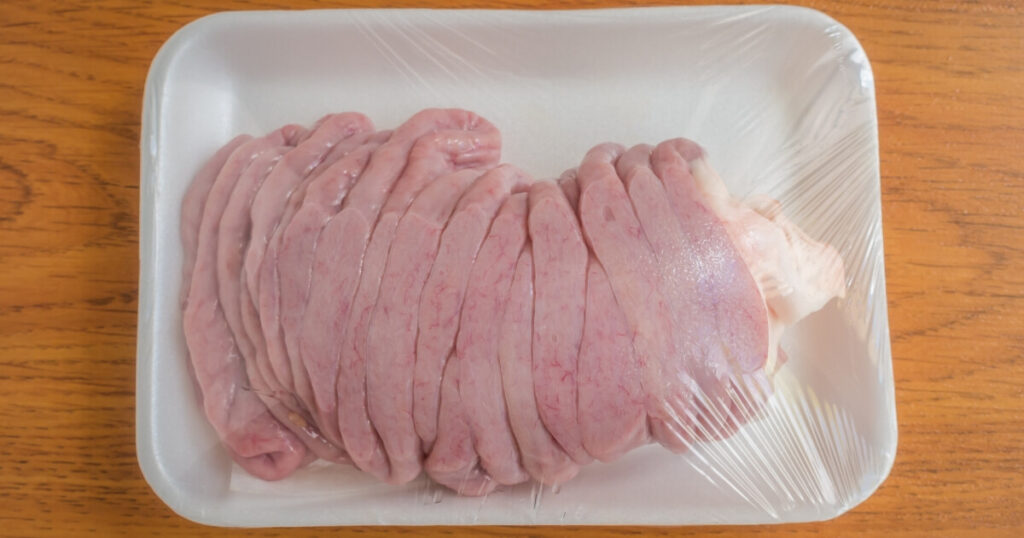
The surface of raw Chitlins is somewhat shiny and slick, with a texture that’s smooth to the touch.
They’re usually sold in long, coiled lengths, and you can see the natural folds and creases of the intestinal lining.
When cooked, the appearance of Chitlins changes quite a bit.
They become a deeper, golden brown color, particularly if they’re fried or grilled.
The surface texture becomes less slick and more varied, with some parts becoming crispy and others remaining soft and chewy.
If the Chitlins are stewed, they may retain more of their original pinkish color but will become more translucent and gelatinous in texture.
One notable feature of Chitlins is their size. While they’re quite long in their whole form, they’re actually quite narrow in diameter.
This is why they’re often cut into smaller pieces for cooking, as it makes them easier to handle and eat.
So, whether you’re looking at raw chitterlings fresh from the butcher or cooked chitterlings ready to be enjoyed, you’ll find that they have a unique appearance that’s quite unlike any other type of meat.
Different Types Of Chitlins
While Chitlins generally refers to the small intestines of a pig, there can be some variation depending on the specific type of pig and the method of preparation. Here are a few different types of Chitlins:
- Domestic Pig Chitlins: These are the most common type of Chitlins and are typically what people refer to when they use the term. They have a strong, distinctive flavor and a chewy texture.
- Wild Boar Chitlins: Chitlins from wild boars can have a more gamey flavor than domestic pigs. They’re often a bit tougher in texture due to the wild boar’s more active lifestyle.
- Organic Pig Chitlins: Chitlins from organically raised pigs can have a slightly different flavor profile due to the pig’s diet and living conditions. Some people find them to have a cleaner, more natural taste.
- Pre-Cleaned Chitlins: These are Chitlins that have been pre-cleaned and partially cooked before being sold. They’re convenient for those who want to skip the labor-intensive cleaning process. However, some people find that they lack the depth of flavor of fresh Chitlins.
- Frozen Chitlins: These are Chitlins that have been cleaned, cooked, and then frozen for storage. They’re a convenient option for those who want to have Chitlins on hand for future use. The taste and texture can be slightly different from fresh Chitlins, depending on how they’re defrosted and reheated.
Chitlins FAQs
What are Chitlins?
Chitlins, often pronounced and spelled as “chitlins,” are the small intestines of a pig. They’re a traditional food in many cultures worldwide but are particularly associated with Southern American cooking.
Why do Chitlins smell so strong when cooking?
The strong smell that Chitlins produce during cooking is because they’re part of the pig’s digestive tract. However, thorough cleaning and proper cooking can help to reduce this smell. Some people also add aromatic ingredients like onions, garlic, or vinegar to the cooking water to help mask the smell.
Why are Chitlins considered a delicacy in Southern cuisine?
Despite their humble origins, Chitlins are considered a delicacy in Southern cuisine due to their unique flavor and the skill required to prepare them. The cleaning and cooking process for Chitlins is labor-intensive, and a well-prepared dish of Chitlins is often seen as a sign of a skilled cook. Additionally, their strong, distinctive flavor sets them apart from other types of meat, making them a unique and sought-after ingredient.
My Tasty Thoughts
One thing I’ve learned from my experiences with Chitlins is the importance of proper preparation.
Cleaning the Chitlins thoroughly, cooking them slowly and gently, and seasoning them generously can make all the difference in the final dish.
In the end, whether you’re a seasoned Chitlins lover or a curious foodie trying them for the first time, I hope this exploration of the taste of Chitlins has been enlightening.

